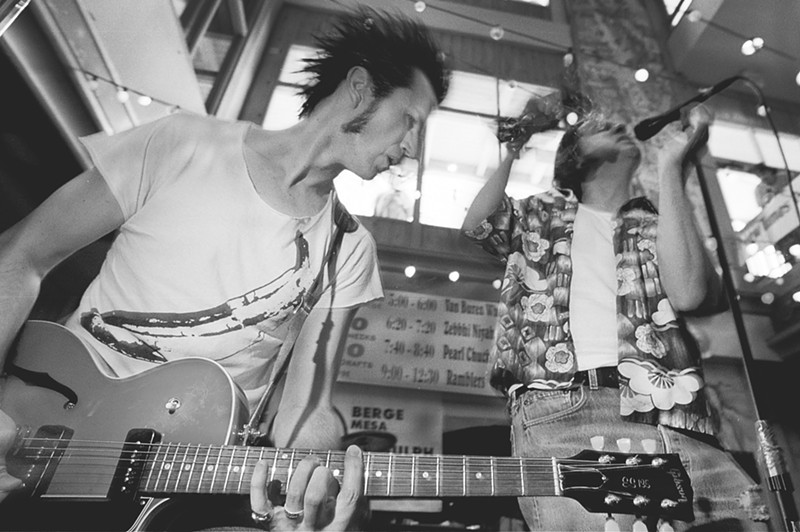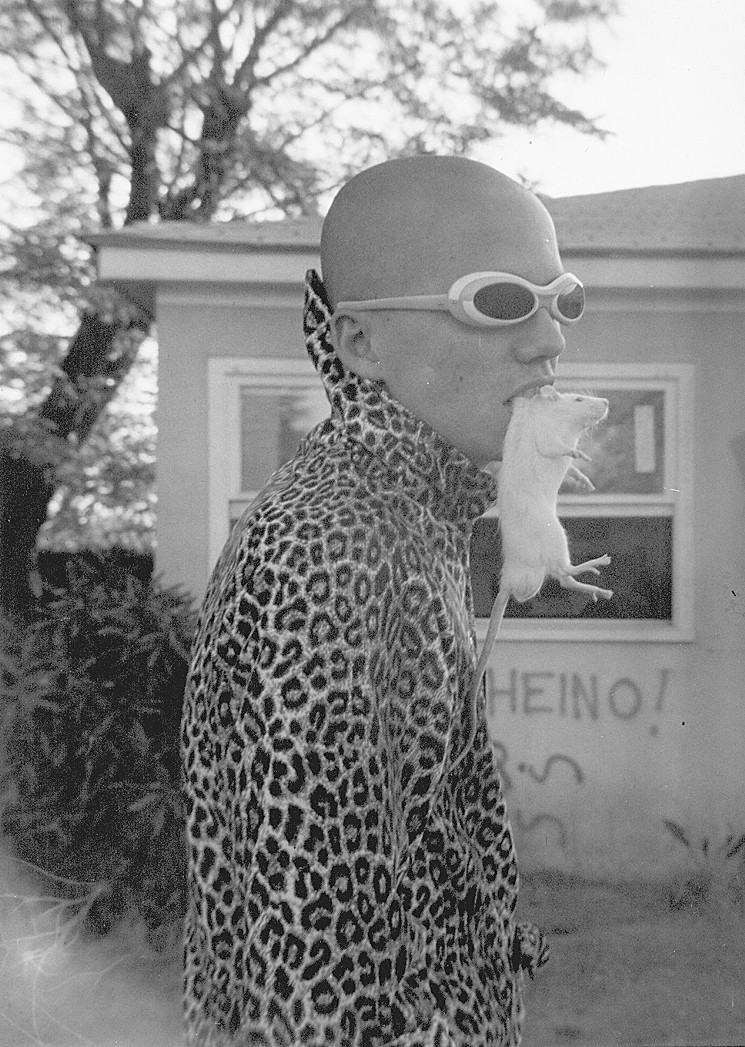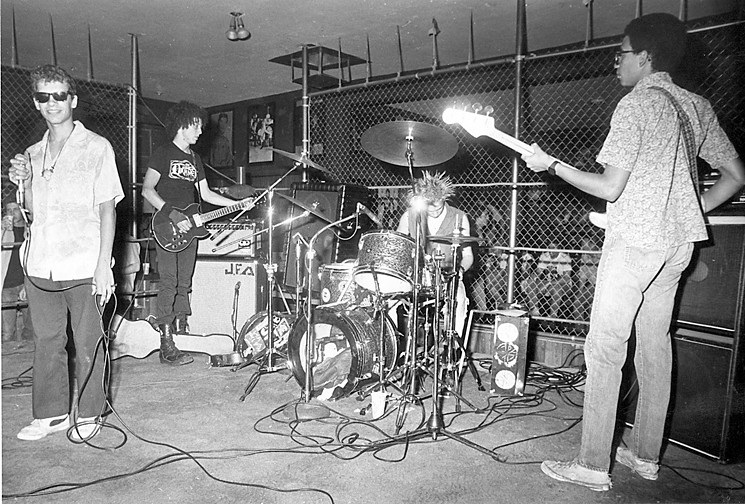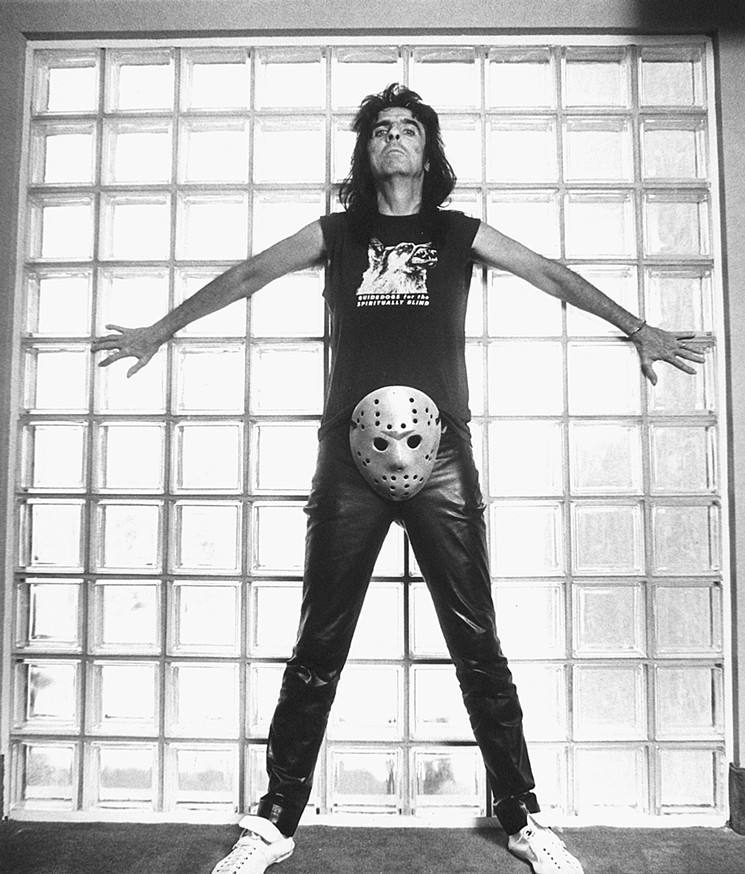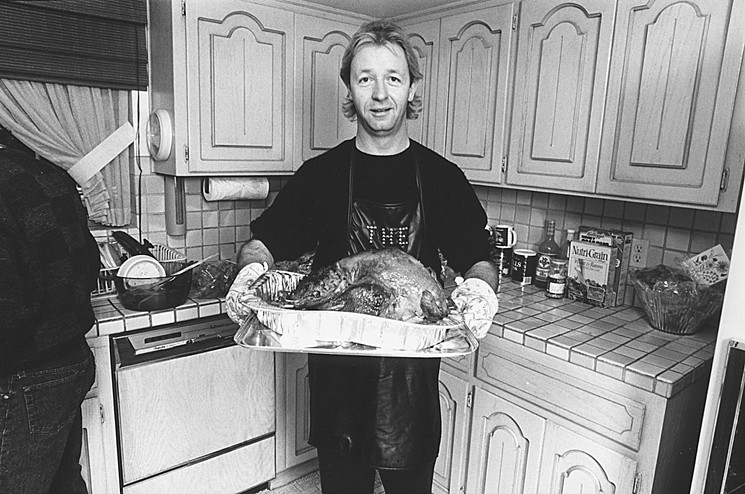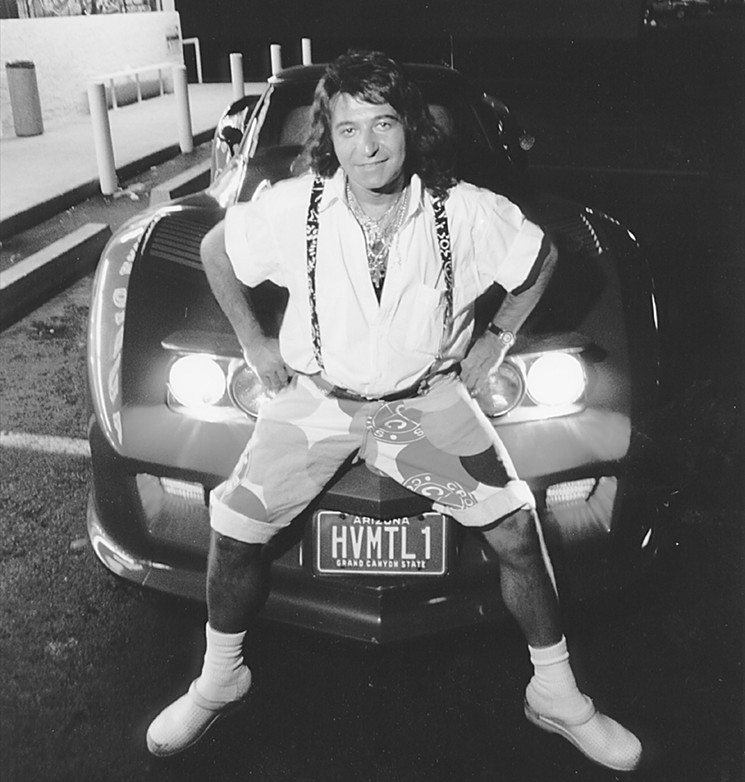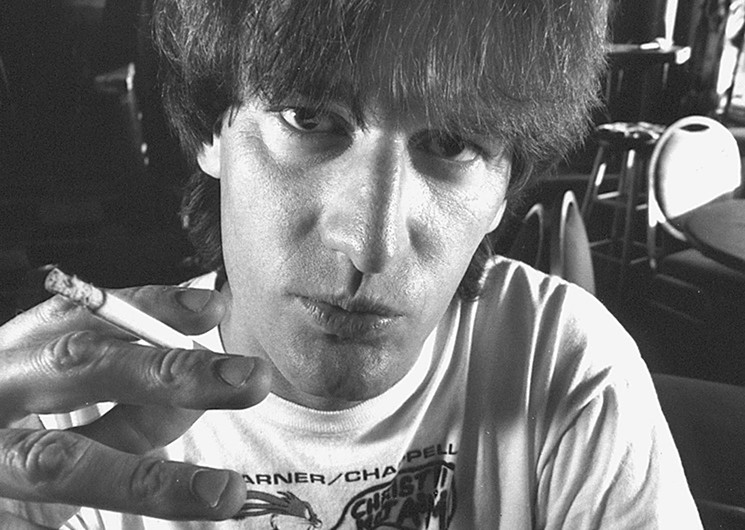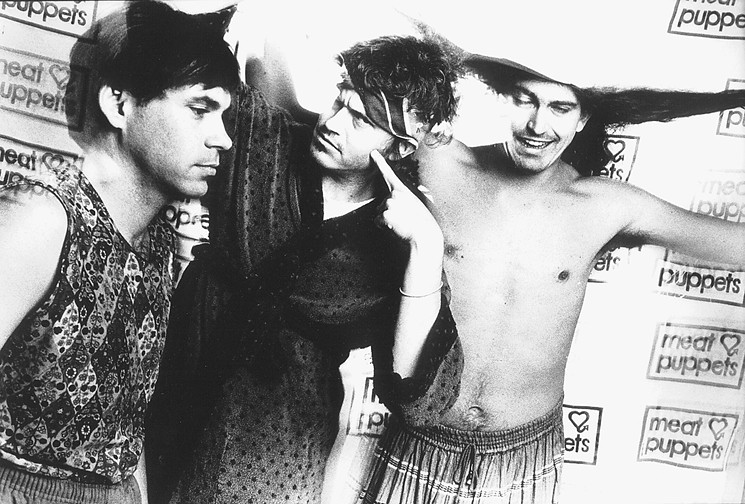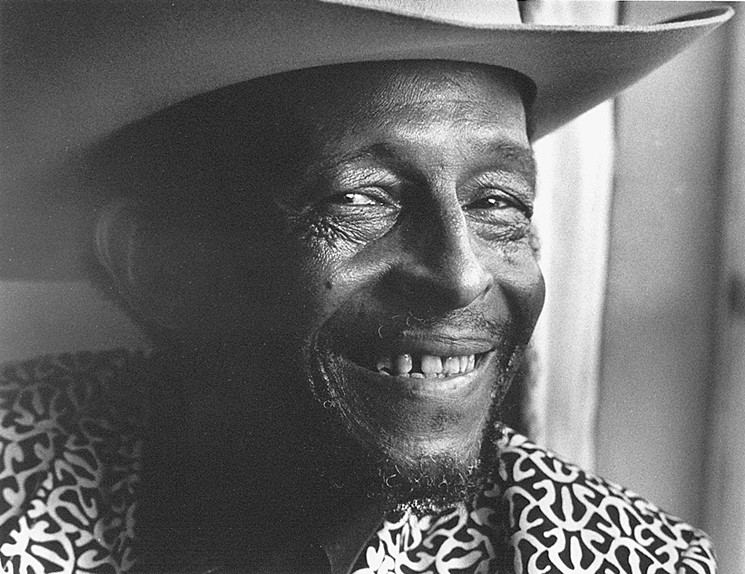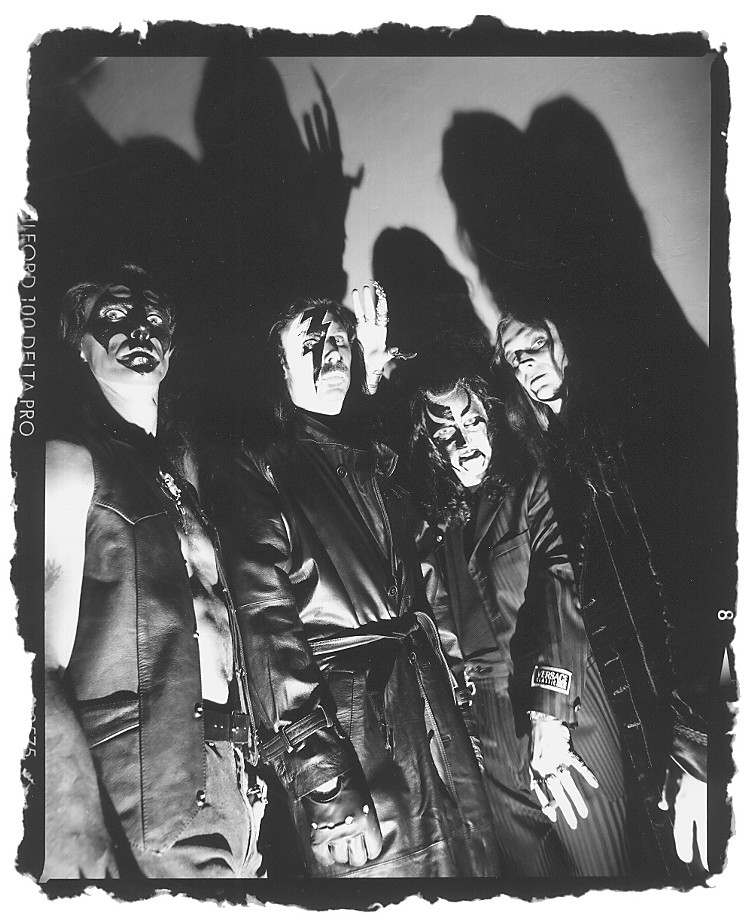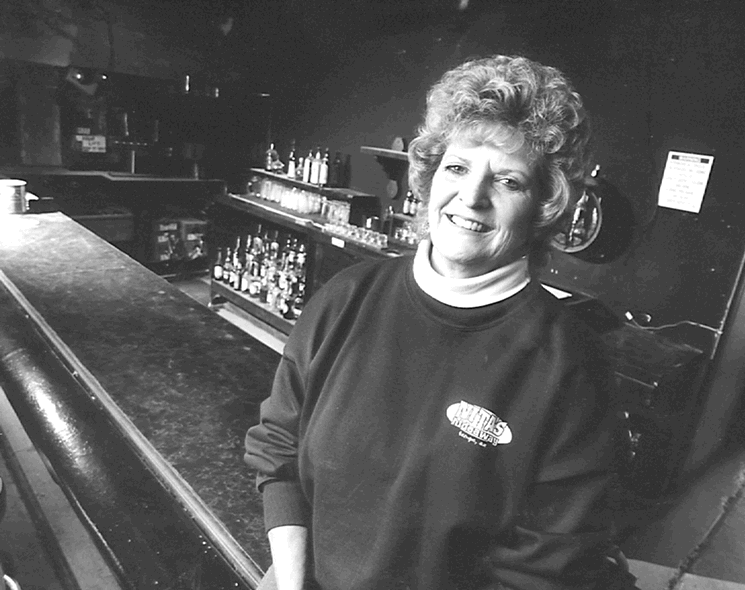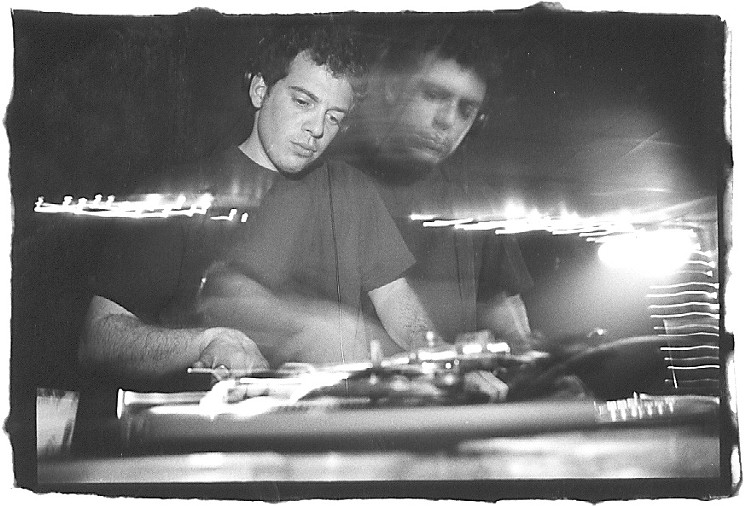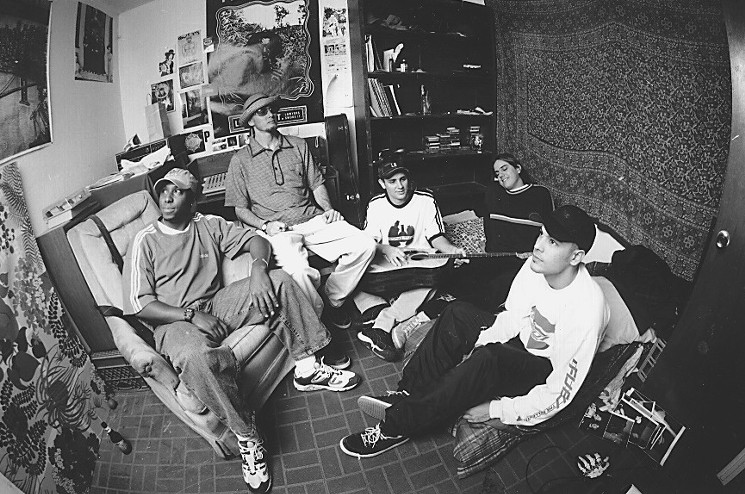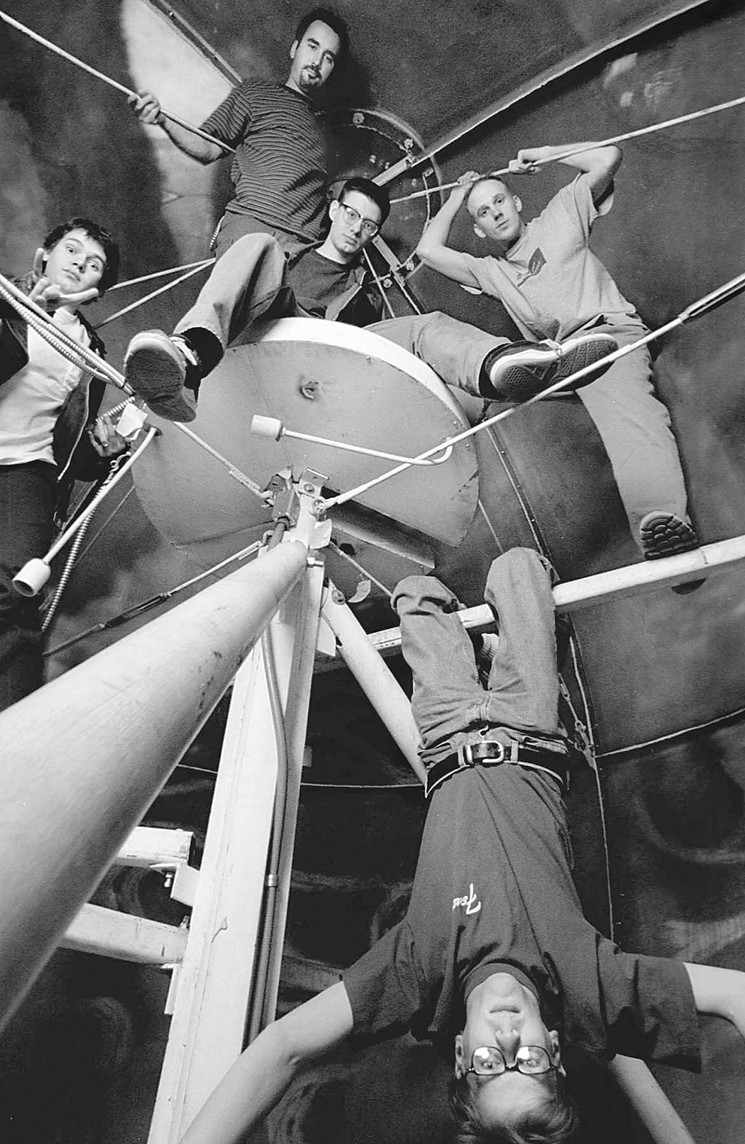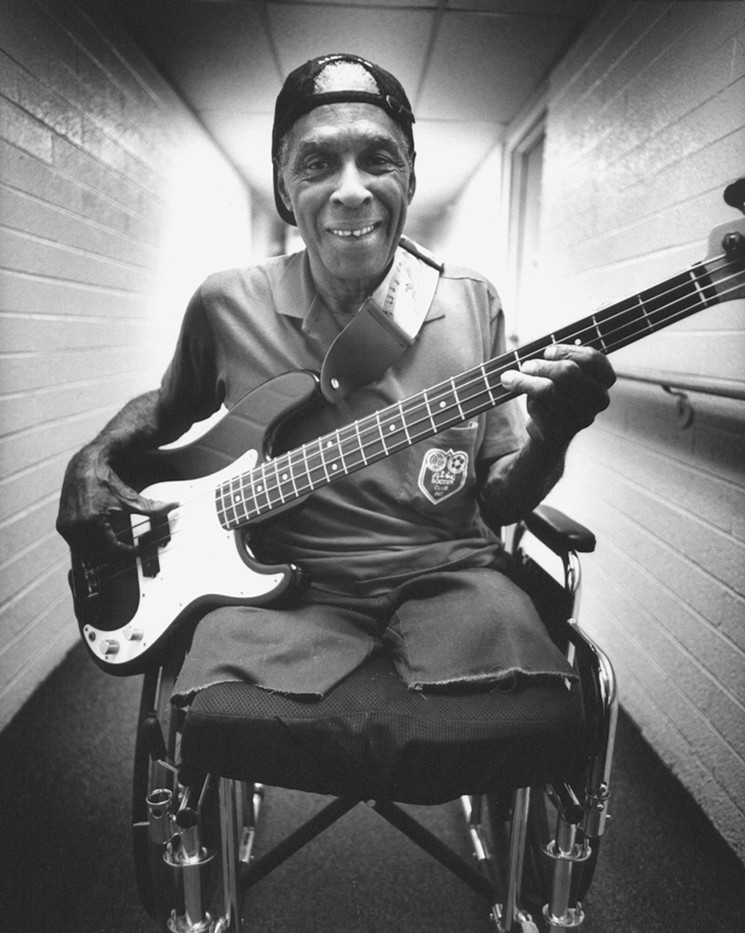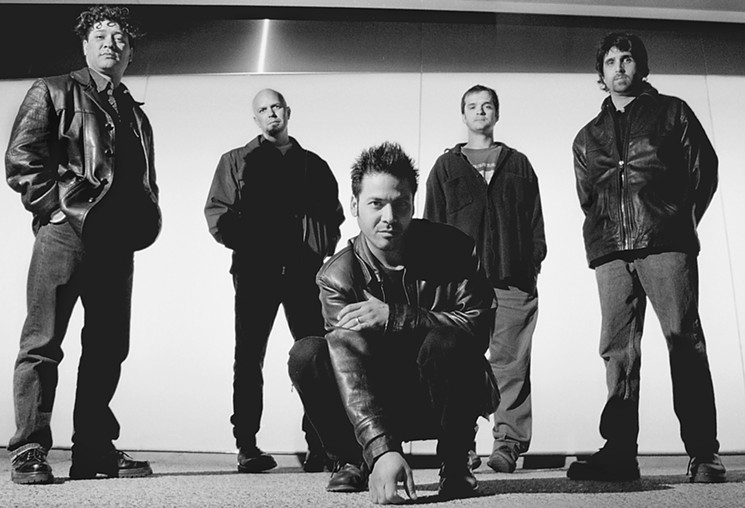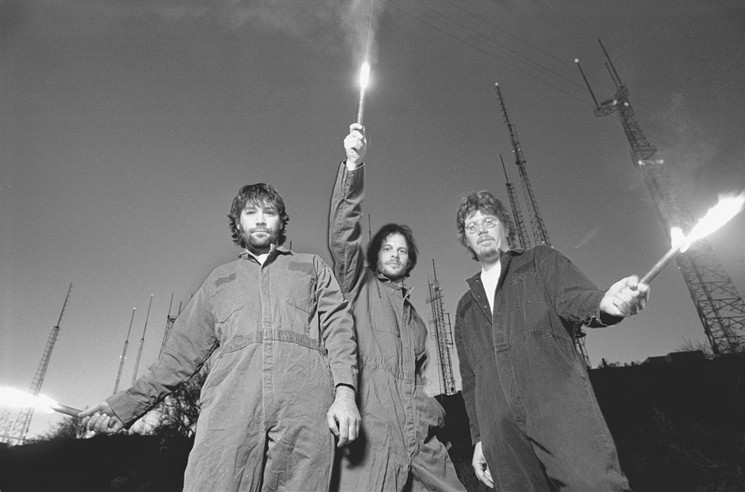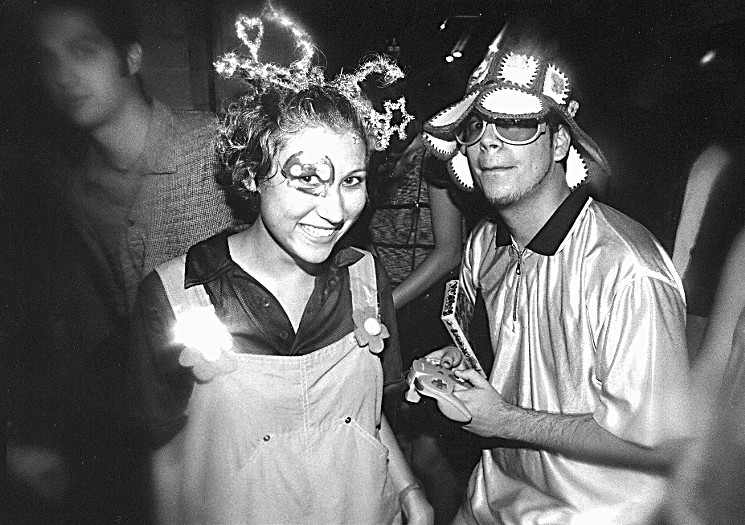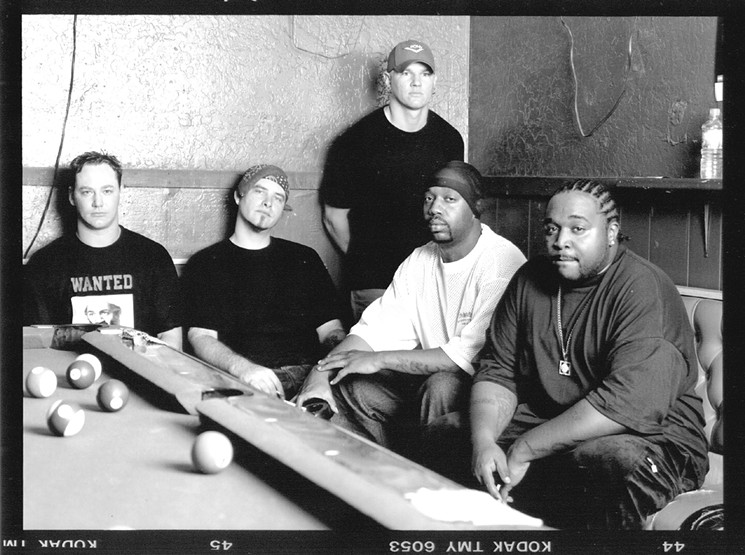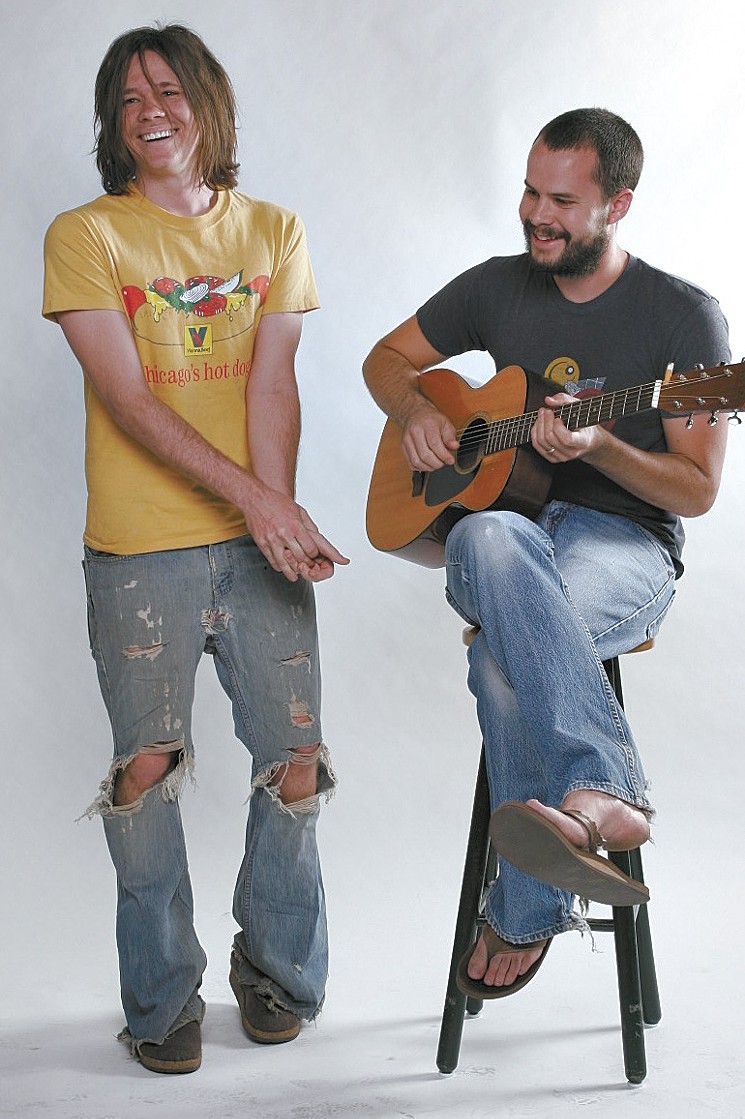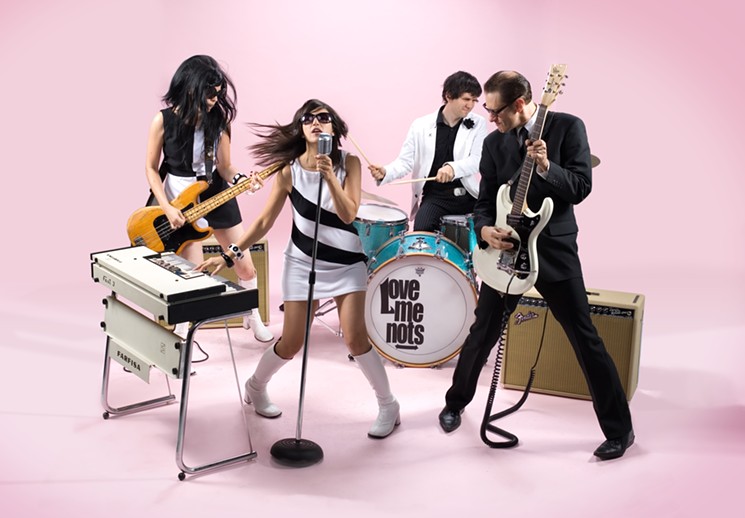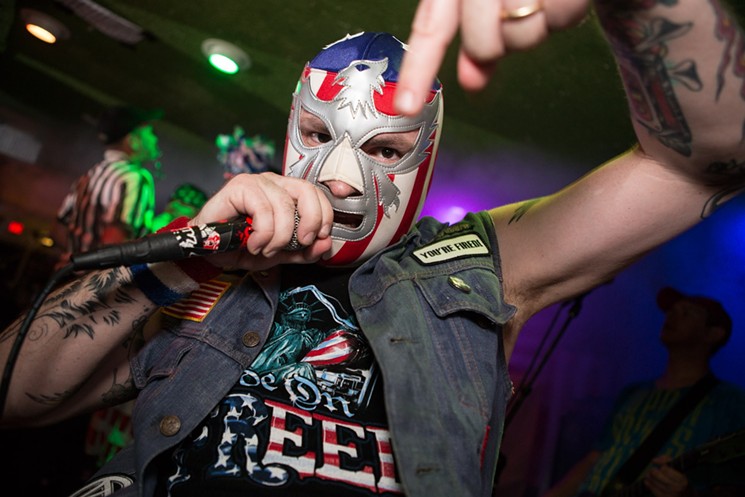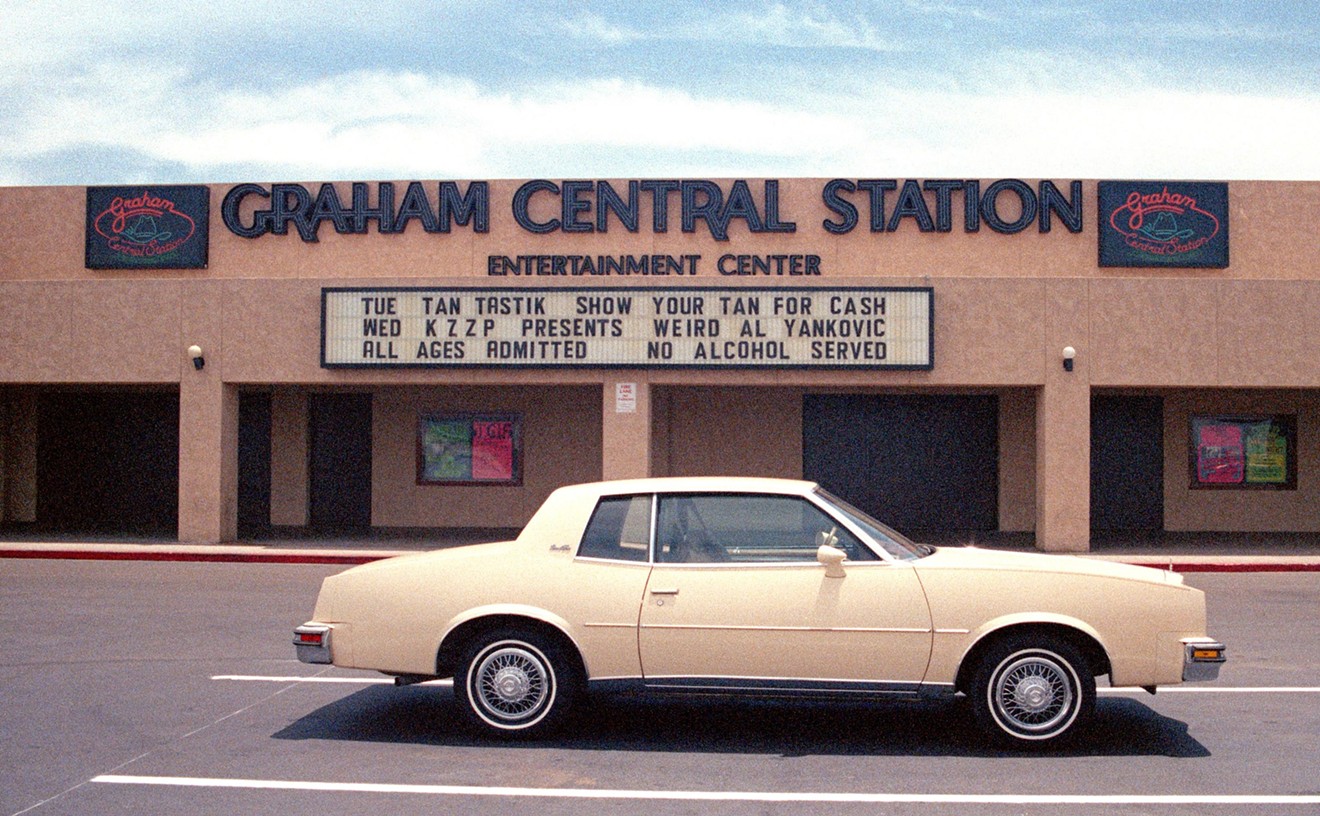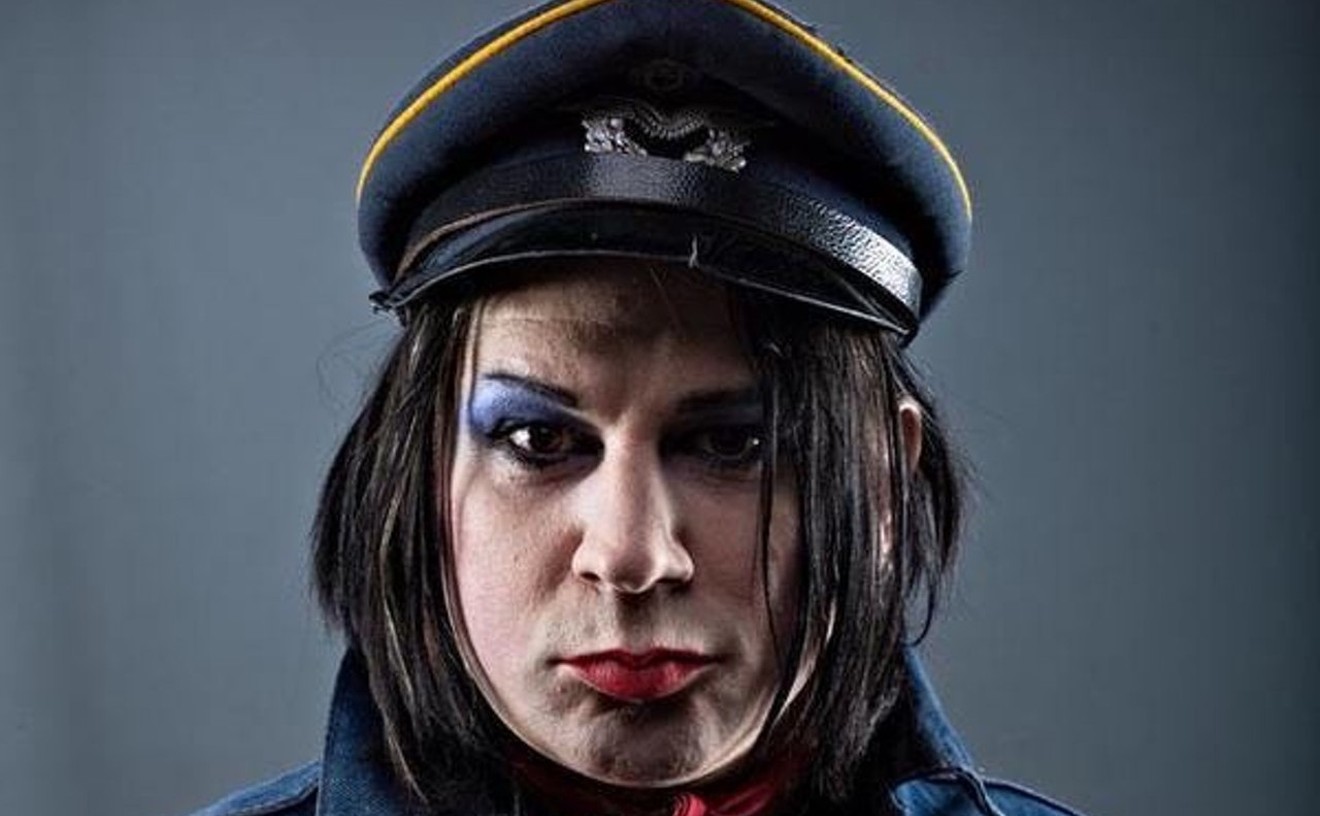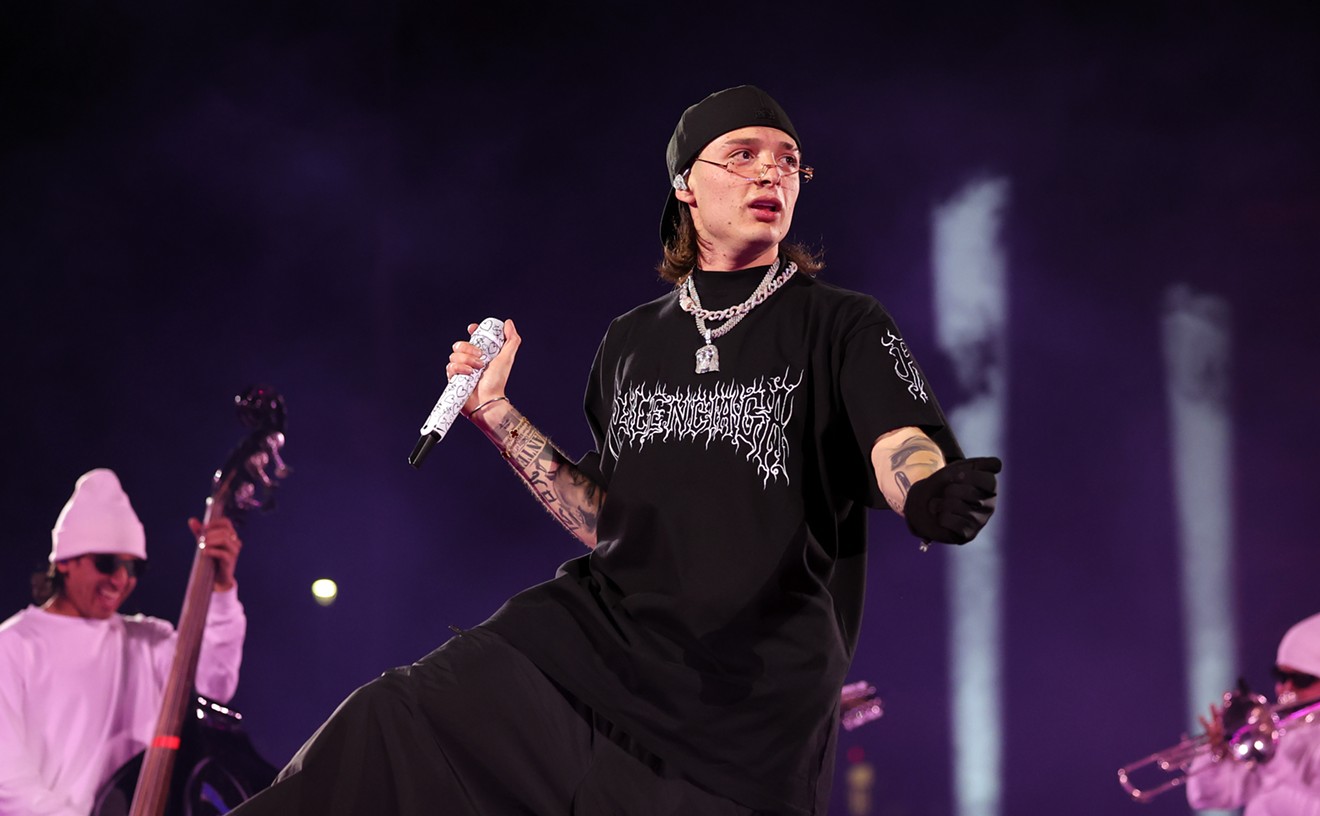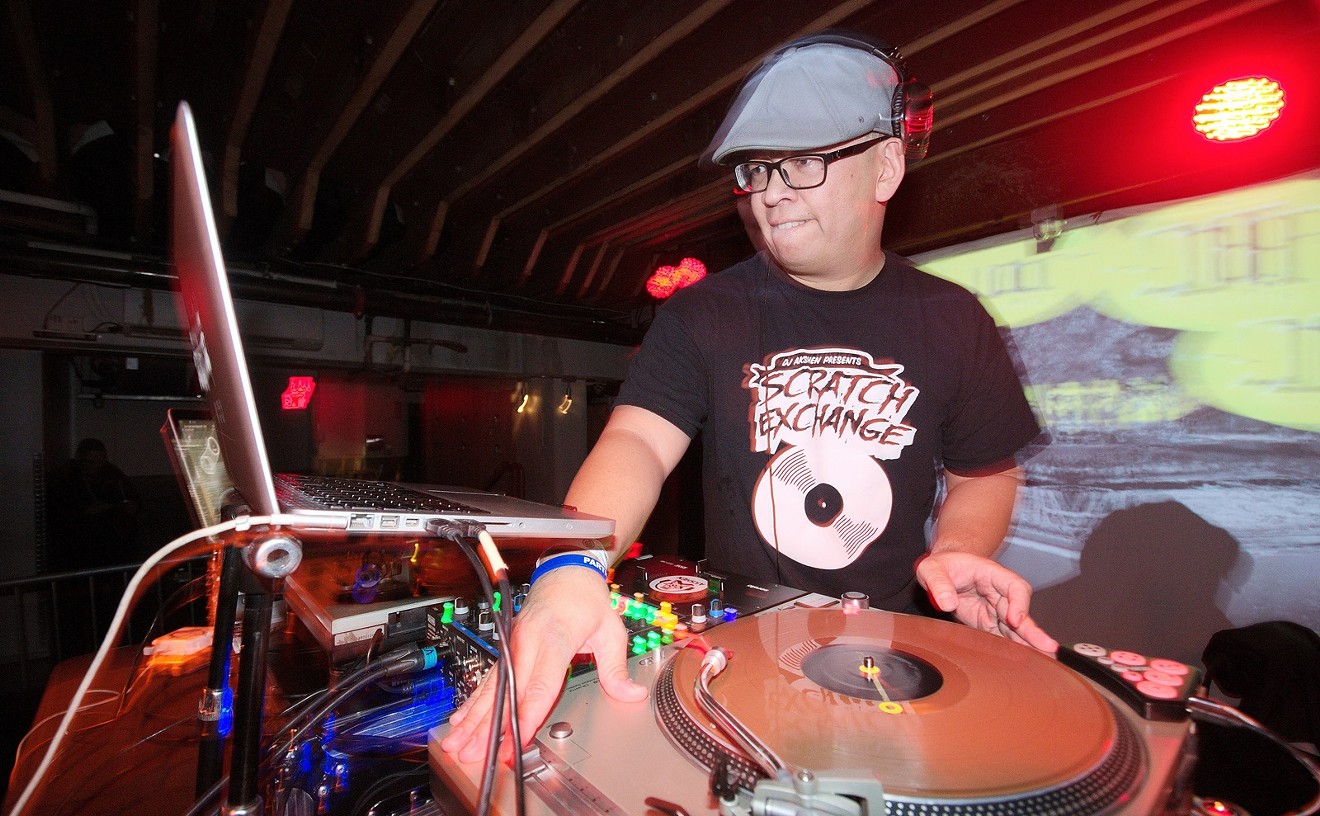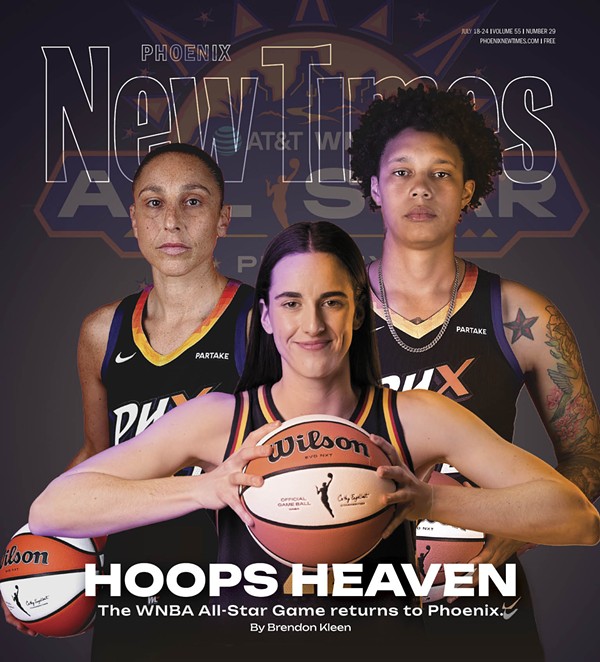This paper covered Phoenix as the rock and pop of the ’70s gave way to punk, New wave, and more underground sounds in the ’80s, followed by the rise of metal, the grunge and hip-hop of the ’90s, the indie boom of the aughts, and the post-genre free-for-all of today. Add it up, and that’s a half-century of stories about the bands, musicians, and performers that shaped Phoenix history.
Our vault also contains many more gems in the form of the photojournalism that accompanied all those pieces. Many offer early glimpses of performers — Alice Cooper, JFA, Sun City Girls, Meat Puppets, Roger Clyne, Gin Blossoms, Z-Trip, and Jimmy Eat World —who would go on to national and international renown.
To close out our 50th anniversary year, we took a deep dive into the New Times archives to unearth some of those photos, many of which haven’t been seen since they were originally published. It’s a diverse collection spanning multiple genres. It includes artists and acts who have shot into superstardom and those that faded into obscurity, forgotten nights and memorable gigs, movers and shakers, crooners and characters, and more than a few dearly departed musicians. Enjoy.
Frank Discussion
Circa late ‘70s/early ‘80sThere are punk frontmen, and then there’s Frank Discussion, the rock provocateur and vitriolic vocalist/guitarist for the notorious band The Feederz. Confrontational, caustic, and more than a little flamboyant, Discussion was known for such stunts as performing naked in seethrough rain ponchos and covering his head with honey and live crickets. Discussion’s antics also featured putting rats in some sort of peril, as seen in the above photo, which also served as the cover art for The Feederz 1979 EP Jesus.
JFA
Circa 1981-1982During the formative years of Phoenix’s punk scene, bands played anywhere they could, be it Jaycee Halls, dive bars, or nondescript event spaces. Starting in the summer of 1981, that included the now-demolished Madison Square Gardens near 37th and Van Buren streets, where shows were held inside a wrestling ring or even behind chain-link fencing. One of the many famed local bands performing at these Mad Gardens gigs was skate-punk pioneers JFA (a.k.a. Jodie Foster’s Army), who brought out the masses.
Gentlemen Afterdark
Circa early 1980sGentlemen Afterdark had everything going for it in the early ’80s: a significant local following, an EP produced by
Alice Cooper, and a People magazine shout-out that called the band “star(s) of the future.” But fame never materialized for the New wave quintet. In fact, its biggest break came 36 years later on Netflix, when the track “Open the Door” was featured on a 2019 episode of Stranger Things.
Alice Cooper
Circa 1980sShock-rock king and longtime Phoenix resident Alice Cooper made a career out of doing whatever the hell he wanted, including donning leather and makeup, mining horror movie influences to creep out audiences, and creating the unholy marriage of rip-roaring rock ’n’ roll with fiendish stage theatrics in the ’70s. Cooper’s yen for slasher flicks and his devil-may-care attitude are evidenced in this undated photo from the ’80s where he adorns his crotch with a Jason Voorhees-style hockey mask.
Rob Halford
Circa 1980sFew things are as wholesome as preparing Thanksgiving dinner for your nearest and dearest, an activity that Judas Priest frontman and (longtime Phoenix resident) Rob Halford happily undertook in this undated photo from the 1980s. Such traditional domesticity clashed with the vocalist’s reputation at the time as a so-called Satanist — a man excoriated by politicians and suburbanites alike for supposedly spreading subliminal messages in the band’s heavy metal anthems.
Franco Gagliano
Circa late '80sWhen the legendary Phoenix venue The Mason Jar is discussed, its longtime owner Franco Gagliano is inevitably part of the conversation. A colorful entrepreneur and Italian immigrant, Gagliano operated the Jar from 1980 until 2005, shepherding The Mason Jar through boom periods, lean times, and several eras of Phoenix’s music scene, from bad cover acts and even worse art-punk bands through the heyday of hair metal and grunge to hip-hop. The club’s legacy lives on in its new identity as The Rebel Lounge.
Doug Hopkins
Circa 1992Without the talents of Doug Hopkins, local jangle-poppers Gin Blossoms wouldn’t have had their two biggest hits in “Hey Jealousy” or “Found Out About You.” (Nor would they have necessarily existed, as the late guitarist and songwriter co-founded the band.) The Blossoms are one of the great Valley music success stories, owing to the success of their 1992 album New Miserable Experience, which helped propel Tempe into the national spotlight. Hopkins, who was kicked out of the band in an ugly split that same year, reportedly due to his substance abuse problems, was a gifted-but-troubled soul who committed suicide the following year.
Meat Puppets
Circa mid-1990sThe members of Meat Puppets may have stepped into the national spotlight when they rubbed elbows with Nirvana on MTV in the early ’90s, but by then, the homegrown act had already cultivated a significant following in the Valley. Originally founded in 1980 as a trio consisting of brothers Curt (right) and Cris Kirkwood (center) and drummer Derrick Bostrom (right), the Puppets straddled scenes and genres, filling local bars, backyards, or underground parties with their weirdo vibes and chimeric mix of rock, punk, and psychedelia.
Chico Chism
Circa mid-1990sBy the time the late Chico Chism got to Phoenix in 1986, courtesy of Rhythm Room owner Bob Corritore, he was already a certified blues legend who had drummed alongside such stars as Howlin’ Wolf, Choker Campbell, Big Joe Turner, and Stevie Ray Vaughn. After taking up residence in the Valley, Chico wowed Rhythm Room crowds on the regular with his talents and charmed everyone he met with his amiable personality.
St. Madness
Circa 1997Heavy metal acts sometimes invoke supernatural forces, but they’re just as mortal as any other band and can break up on a whim. The fiends of St. Madness have stuck it out for almost two decades, terrorizing local venues with thunderous riffs and otherworldly vocals since the early ’90s. And they’re still wearing face-paint to amp up the theatrics.
Nita Craddock
Circa 1998Ages before he founded such wildly popular venues as Crescent Ballroom and The Van Buren, concert guru Charlie Levy was booking shows to great success at the tiny, out-of-the-way dive Nita’s Hideaway in Tempe. It was all made possible by namesake and owner Nita Craddock, the late rodeo queen he roped into turning her joint into a music venue in 1995. She allowed Levy to build a stage, buy a sound system, and bring in local and touring acts, transforming Nita’s into a hub for indie and tastemaking rock.
Z-Trip
Circa late '90sIn the mid-to-late ’90s, Zach Sciacca, better known as Z-Trip, was one of the Valley’s reigning kings of the turntables. As a member of the Bombshelter DJs along with Emile and Radar, he put needles to wax at clubs, hip-hop nights, and parties in Tempe and Phoenix. Meanwhile, Sciacca was getting props from Spin and URB for his mesmerizing turntable talents, particularly with mashups, which he parlayed into a solo career, notable albums like 2005’s Shifting Gears, and a gig opening for the Rolling Stones, before becoming a superstar himself.
Cousins of the Wize
Circa late '90sStarting in the late ‘90s, you could find the members of Cousins of the Wize performing at music venues around town or sharing bills with the likes of Cypress Hill, Run-DMC, De La Soul, and Fishbone. New Times described the collective, which featured up to eight members or more at any one time, as the “closest thing to a hip-hop supergroup in Phoenix” that “[established] a reputation as an energetic, unpredictable live act that deftly blended reggae beats with jazzy horns and hip-hop lyrical flows, all wrapped up in an alt-rock sensibility.”
Pollen
Circa 1998Band photos are often an endless sea of musicians attempting to look cool while standing amid stunning outdoor vistas, gritty urban settings, or their friend’s backyards. Not so with now-defunct power pop band Pollen, who was photographed by hanging out inside a giant metal globe from an old Planet Hollywood location at a south Phoenix junkyard in 1999.
Henry “Mojo” Thompson
Circa 1999The late Henry “Mojo” Thompson started playing the blues in 1958 — first as a drummer, later as a vocalist and bassist — and kept playing, even after enduring various health issues that caused him to undergo numerous surgeries and amputations. During his four-decade career in the blues biz, Thompson, who died in 2004, sang with doo-wop group the Tads, toured with the R&B act Seven Souls, and played with such local legends as Small Paul Hamilton, Big Pete Pearson, and Duke Draper.
New Times Music Showcase
Circa 1999Music festivals have been a springtime staple for decades; New Times has even put on a few of our own. To wit: Every April from 1996 until 2006, we transformed Mill Avenue in downtown Tempe into an experience not unlike South by Southwest during the annual New Times Music Showcase. Each year, more than four dozen bands across a multitude of genres — from rock and pop to R&B and hip-hop — invaded the bars and venues of Tempe’s then-thriving live music landscape to spotlight the best performers and bands the Valley had to offer.
The Pistoleros
Circa 1999Led by brothers Mark and Lawrence Zubia, the Pistoleros started life as The Chimeras and became a beloved local roots-rock outfit that stood out during Tempe’s fabled run as a national music hotbed in the ’90s. A deal with Hollywood Records in 1997 may not have translated to further success, but the band maintained a fervent local fanbase over the years, which only grew after The Pistoleros reunited in 2013 following a lengthy breakup. Lawrence (center) died last year from pneumonia.
Gas Giants
Circa 1999When former New Times staff photographer Paolo Vescia gathered on South Mountain Park for a photo shoot with the members of Gas Giants — the pop-rock band fronted by Robin Wilson (center) after stepping away from Gin Blossoms in the late ‘90s — it almost ended in disaster. Vescia recalls being chased away by rangers after getting pics of the band holding road flares. “We’re lucky we didn’t wind up in jail,” he says.
Ravers Raving
Circa early 2000sWhen electronic dance music and rave culture’s popularity were at their apex in the late ‘90s into the early 2000s, underground dance affairs were in abundance. Locations ranging from warehouses and other off-the-radar locations to more legit spots like the Icehouse were lit up every weekend. Local DJs like LEGO and Markus Schulz were in demand, crowds numbered into the thousands, and countless nights were spent dancing until dawn under the influence of PLUR, not to mention various mind-altering substances.
Bionic Jive
Circa early 2000sRap-metal combo Bionic Jive was a staple of both rock and hip-hop shows in the Valley during the late ‘90s and early 2000s. Formed in 1998, the group featured guitarist (and famed recording engineer) Larry Elyea, bassist Richard Gartner, drummer Chris Elsner, and MCs Emerg McVay and Ako Mack. Bionic Jive flirted with mainstream success during its first four years, releasing Armageddon Through Your Speakers on Interscope Records in 2001 and touring with Eminem, Kottonmouth Kings, and the D12.
Kimber Lanning
Circa 2001Kimber Lanning’s influence on music in the Valley goes back nearly four decades. She started out behind the counter at Zia’s original location in the early-’80s before founding Stinkweeds Records in 1987. It helped lead her to launch to a Roosevelt Row gallery Modified Arts (which also hosted shows for a decade) a few years later and eventually moved her record emporium to downtown (where it’s survived the turmoil of the music industry and become a go-to destination for music gourmandizers). These days, she runs Local First Arizona, a non-profit focusing on independently-owned businesses.
The Format
Circa 2006When Nate Ruess and Sam Means debuted their indie-pop duo The Format in 2001, their success wasn’t due to their major-label deal with Elektra Records, but rather heavy rotation on local radio and word of mouth across MySpace and other social media platforms of the era. (Ruess’s golden voice and the pair’s songwriting talents probably helped, too.) They went on to influence artists like Panic! at the Disco’s Brendon Urie before breaking up in 2008, only to reunite last year.
The Love Me Nots
Circa 2006Retro revival act The Love Me Nots was one of the Valley’s first bands to break out on MySpace, back during the heyday of the pioneering social media platform. Fronted by vocalist/organist Nicole Laurenne and renowned for their rowdy performances, sharp-looking attire, and go-go-meets-garage sound, the band exploded onto the local scene in the mid-to-late 2000s.
KISS
Circa 2014You might call KISS the very definition of rock 'n' roll cliches or sellouts, but you can't say they don't put on one helluva concert. The legendary band’s showstopping performances are filled with lights, pyro, and plenty of theatrics. Case in point: Their July 2014 gig at Ak-Chin Pavilion along with Def Leppard, which saw KISS go all-out and over-the-top with the spectacle, including Paul Stanley taking an enormous leap, which was captured by frequent New Times photographer Jim Louvau.
BroLoaf’s Annual Patriotic Meltdown
Circa 2014BroLoaf’s annual Patriotic Meltdown parties at the Yucca Tap Room in Tempe every Fourth of July are PBR-soaked burlesques filled with calamity, costumes, and comedy. The local punk band mixes jingoism with surrealism at these sloppy affairs, where the mosh pit is sprayed with beer, politicians are mocked, and over-the-top chants of “U.S.A.!” are the norm.
Maynard James Keenan
Circa 2015We’ve admittedly had an up-and-down relationship with Maynard James Keenan over the past decade. We’ve devoted plenty of ink to the enigmatic vocalist of Tool, Puscifer, and A Perfect Circle, including during his brief stint as a semi-regular New Times columnist in 2012 and 2013. He’s also graced our cover a handful of times, most recently for a 2015 feature story.
Futuristic
Circa 2015Up until 2015, Arizona never really had any breakout hip-hop stars. Enter Zachary Lewis Beck, better known as Futuristic, whose music video for his track “The Greatest” went viral to the tune of 10 million YouTube views while his debut album, The Rise (a mix of hip-hop, pop, and trap) rocketed up the iTunes charts. No wonder we dubbed him the “new king” of Phoenix’s hip-hop scene.

